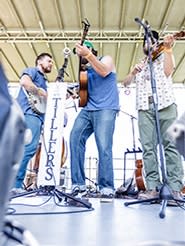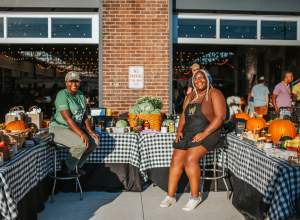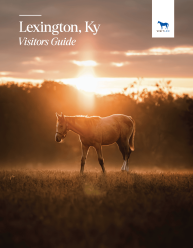Curious about Bluegrass Music? Here's some information to put you in a Bluegrass state of mind.
The grass. The state. The region. The music. If you are planning a visit to Central Kentucky, you've probably already discovered that the term Bluegrass is liberally applied to subjects that at first may seem dissimilar. If it's Bluegrass music that strikes a chord with you, read on to learn about our state's connection to this unique genre of American music. We'll start by explaining how a grass becomes a musical style.
Poa Pratensis: The Grass
Bluegrass is believed to have been brought to the U.S. by early settlers. Also known as smooth meadow-grass, or common meadow-grass, it is an excellent grass for grazing livestock. The seeds can withstand harsh weather conditions and would have been a good choice for pioneers traveling to build a new life in uncertain conditions. This type of perennial grass grows especially well in Kentucky's limestone soil, and quickly established itself. Though certainly not "blue" in color, Poa Pratensis, when allowed to grow to its full height, does form blue flower heads. The rich deep green color of this grass can appear to have a blueish hue when compared to other grasses.
Kentucky: The Bluegrass State
With a global reputation for scenic beauty, the varied landscape of Kentucky ranges from the "land of lakes" in the west to the Appalachian mountains in the east. In between are our famous gently rolling hills of Bluegrass pastureland. So renowned are these lush and fertile pastures that the entire state is referred to as the Bluegrass State.
The Bluegrass Region
The area of central Kentucky known as the Bluegrass Region is only 1/5 of the area of the state. Anchored by the second largest city in the state, Lexington, this region gave rise to the state's two signature industries: the horse industry and the bourbon industry. Geologically and ecologically distinct from the rest of the state, it is the image of this iconic region that captivates so many people around the world.
Bluegrass: The Music
While the grass is believed to be an introduced species, probably brought over from Europe or Africa, the music was born of this land. In the 1940s, Kentuckian Bill Monroe created a sound so distinct from other "country" music that it was given its own name: Bluegrass, after the name of his band "The Blue Grass Boys." Nearly 75 years later, this Kentucky product, like our horses and our Bourbon, has garnered fans around the globe.
That High Lonesome Sound
You know it when you hear it. Your foot starts tapping while a string band plays a lively rhythm. Singers move to the mic to produce high-pitched harmonies and then take turns showing off on their chosen instrument. But even Bluegrass musicians don't always agree on what Bluegrass music "is," though it doesn't take them long at all to decide in which key to play it! Even the International Bluegrass Music Association forgoes offering a definition on their otherwise extensive website.
No one disputes that the sound originated with Bill Monroe and his Blue Grass Boys. Most agree that the sound of classic Bluegrass music solidified when Earl Scruggs joined the band and brought with him his distinctive three-finger picking style on the banjo. In 1948 he left to form his own group, Flatt & Scruggs, the second most important band in the development of the genre.
|
Bluegrass Note: Owensboro, in western Kentucky, is home to the Bluegrass Music Hall of Fame and Museum, dedicated to preservation and innovation in bluegrass music. Just 45 minutes south of Owensboro you'll find the homeplace of Bill Monroe. |
Traditional Bluegrass music will feature acoustic guitar, mandolin, fiddle, upright bass and five-string banjo played in the three-finger picking style made popular by Earl Scruggs. As in Jazz, instruments are featured in turn with improvisational solos that show off the virtuosity of the player while the other instruments strum back up. The vocals are often close two or three-part harmony. Bluegrass singers are likely vocalizing at the upper reaches of their range, perhaps in part because Bill Monroe himself was a tenor. It is this intense and evocative vocal style so characteristic of the genre that is known as the "high lonesome sound."
Make no mistake; musicians can, and do, argue long into the night about the exact differences between Bluegrass music and other styles such as mountain music, old tyme music, country, roots, Americana, grassroots, folk and progressive folk. But they all recognize its Kentucky origins. The seeds of Bluegrass have been carried far from Kentucky, and continue to take root and flourish in countries all over the world.
|
Bluegrass Note: The "banjar", made from half a gourd and animal skins, originated in Africa hundreds of years ago. The five stringed banjo used in Bluegrass music developed from earlier four stringed banjos fashioned by African slaves in the 17th century. It's not certain how the short fifth string developed, but it was definitely in use by the early 1800s. |
For Your Listening Pleasure
When you are visiting Lexington, be sure to check out these venues for Bluegrass music.
 Red Barn Radio. On Wednesday nights, join the audience for a performance of Bluegrass and traditional music that is recorded live for radio broadcast. Red Barn Radio's home base is the Performance Hall at ArtsPlace, 161 North Mill Street in Lexington.
Red Barn Radio. On Wednesday nights, join the audience for a performance of Bluegrass and traditional music that is recorded live for radio broadcast. Red Barn Radio's home base is the Performance Hall at ArtsPlace, 161 North Mill Street in Lexington.
Southland Jamboree. Bring a lawn chair or blanket and make yourself at home for free outdoor Bluegrass music concerts every Thursday throughout the summer. Bring your instrument and join in the post-show jam session. The Southland Jamboree season is May-September and is held at the Moondance Amphitheatre.
WoodSongs Old Time Radio Hour. Heard in more than 500 markets around the world, this radio show is taped live at the historic Lyric Theatre in downtown Lexington. Nationally known Bluegrass acts join a line up of traditional and folk music year-round. The show starts at 7 pm on Mondays, but come early. The audience needs to be seated by 6:45. Admission is $10.
Akemon's Barber Shop. Do you play? Would you like to brag that you've played Bluegrass in the Bluegrass? Join in a jam session at Akemon's Barber Shop in Paris, about 30 minutes north of downtown, on Tuesdays from 3:30 p.m. to around 6 p.m. If you don't play, you're still welcome to drop by and listen. Call first: (859) 987-3875.
Windy Corner Market and Restaurant. With their emphasis on locally produced foods, it's no wonder that when there is music on the menu, it is likely to be Bluegrass. Call for the schedule, but there's often music starting around 6 p.m. on Fridays. (859) 294-9338.
|
Bluegrass Note: Every fall, the John Jacob Niles Center for American Music presents free noon time Friday concerts of Bluegrass music. All concerts are in the Niles Gallery of the Lucille C. Little Fine Arts Library just off Rose Street at the University of Kentucky. (859) 257-4008 |
Written by Lu Ann Pelle, December 2014
Updated September 2022
Copyright: Lexington Convention and Visitors Bureau

















